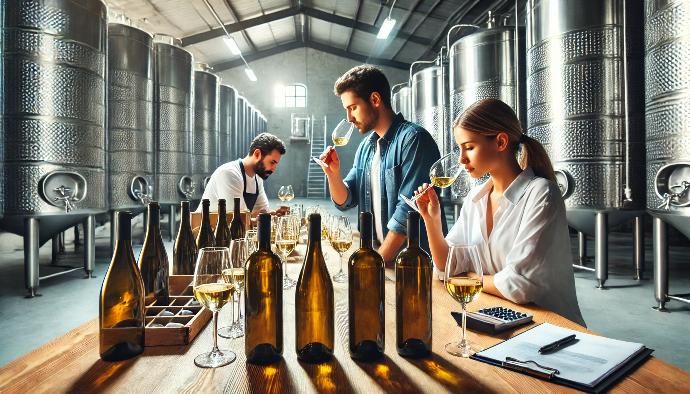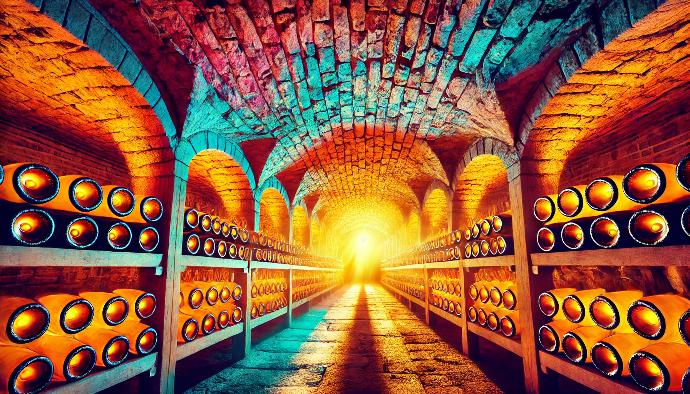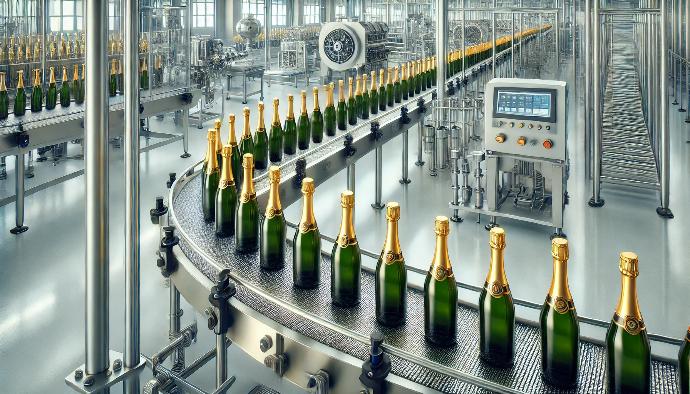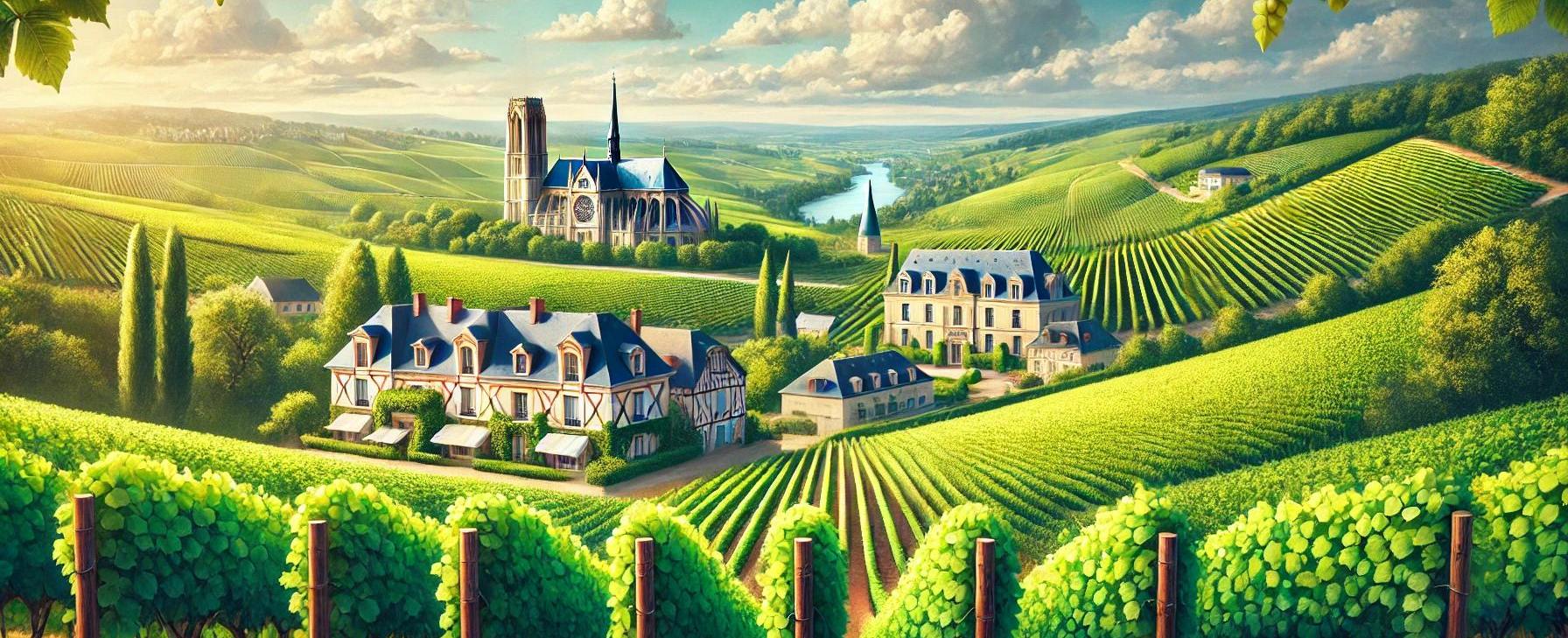
Wine tourism in Champagne
Wine Tourism in Champagne: destination information, how to move in Champagne, Top Wine Experiences, Itineraries and tours, tips and secrets.
Champagne, nestled in the northeastern part of France, is a region synonymous with celebration and sophistication. Famous for its sparkling wines, Champagne offers a unique blend of historical significance, breathtaking landscapes, and rich cultural heritage. The region’s heart, Reims, is home to the magnificent Gothic cathedral where French kings were crowned, adding a touch of grandeur to the area.
In this guide, we'll journey through the lush vineyards, charming villages, and grand Champagne houses that define this illustrious region. You'll discover how the unique terroir and traditional winemaking methods create the world's most celebrated sparkling wines. From the quaint streets of Épernay, lined with prestigious Champagne producers, to the rolling hills covered in vines, every corner of Champagne exudes elegance and history.
Experience the magic of the Champagne region, known for its prestigious appellations and iconic bubbly. Whether you're looking for immersive tours, exquisite tastings, or gourmet food pairings, Champagne promises a memorable adventure for every wine lover.
If you're already acquainted with Champagne and its sparkling delights, feel free to skip this guide and start your search for Champagne wine experiences available on winedering.com.
The Destination: Champagne
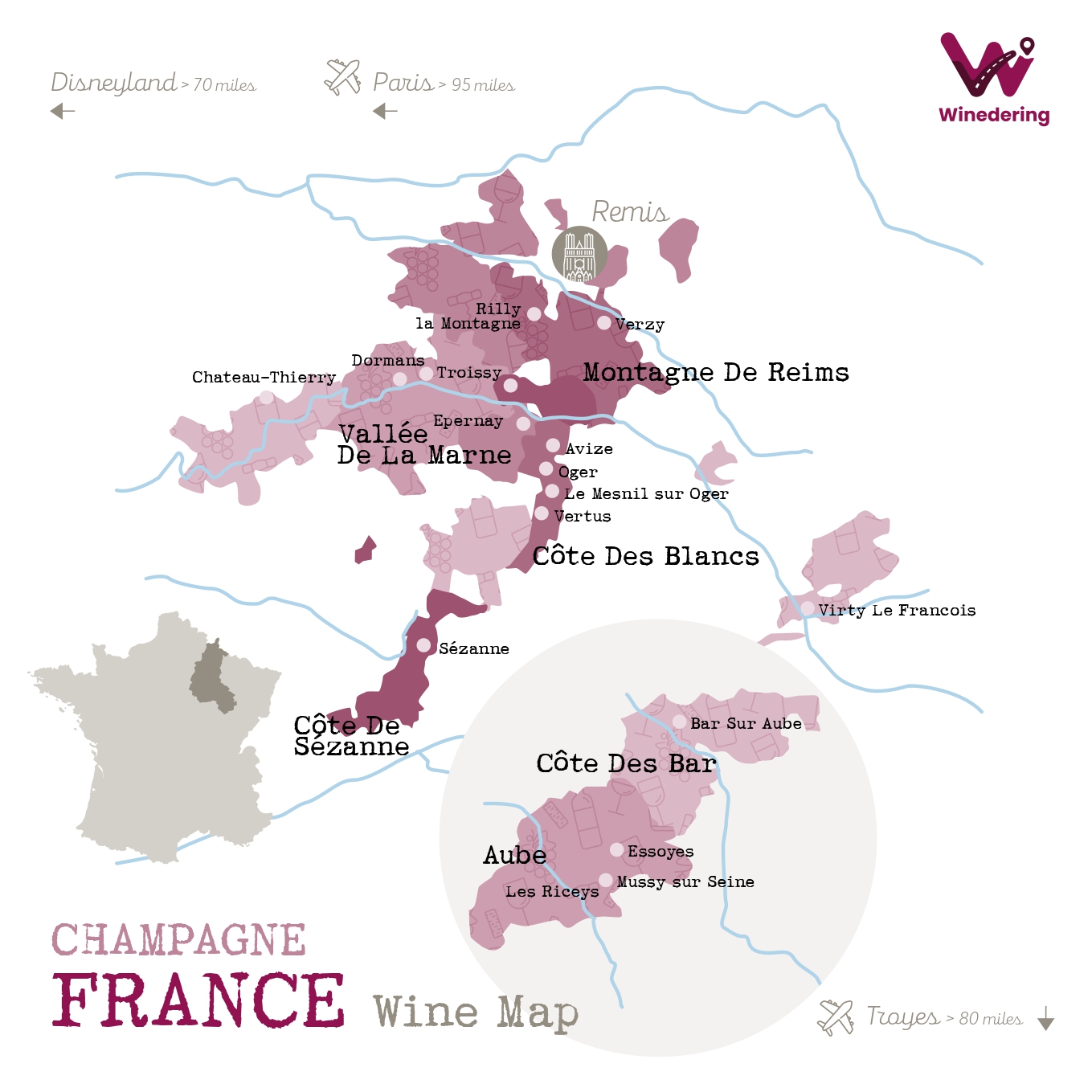
Welcome to Champagne, a region synonymous with luxury and celebration!
Champagne's unique terroir is shaped by its chalky soil and cool climate, ideal for producing world-renowned sparkling wines. The region's history is rich, dating back to Roman times, with significant development during the Middle Ages and Renaissance. Today, Champagne is home to famous vineyards and over 300 Champagne houses.
The towns of Reims and Épernay are central to the region’s winemaking heritage. Reims boasts stunning Gothic architecture, including the famous Notre-Dame de Reims Cathedral, where French kings were once crowned. Épernay, often called the “Capital of Champagne,” features the prestigious Avenue de Champagne, lined with grand Champagne houses. Visitors can explore extensive underground chalk cellars that provide a fascinating glimpse into the traditional methods of Champagne production.
A must-visit destination for wine enthusiasts, the natural beauty of Champagne extends beyond its vineyards, offering scenic drives, hikes, and cycling routes through picturesque villages and rolling hills. Explore medieval cities, and soak in the beauty of Montagne de Reims Regional Natural Park.
Before exploring experiences offered in the region, let’s discover how to reach the region of Champagne.
Napoleon Bonaparte had a significant relationship with Champagne, most notably through his close friendship with Jean-Rémy Moët of Moët & Chandon. This bond led Napoleon to visit the Moët estate before every military campaign to stock up on champagne. Napoleon also popularized the tradition of sabrage (the technique of opening a champagne bottle with a saber), as his cavalry used sabers to open bottles of champagne during celebrations. The legacy of this connection is honored by Moët & Chandon with their flagship Champagne, Moët Impérial, named in his honor.
How To Reach Champagne
When planning a trip to Champagne, consider these three main travel routes to make the most out of your trip.
Route 1: Day trip from Paris
Take a day trip to Champagne during your stay in Paris. There are numerous options for tours, including visits to Reims and Épernay for Champagne tastings and vineyard explorations.
Route 2: Northern France Tour (Champagne – Normandy – Loire Valley)
Start your journey in Paris, enjoying its iconic landmarks, museums, and culinary delights. Take a short trip east to the Champagne region, visiting Reims and Épernay for tastings and vineyard tours. Then, head northwest to Normandy to explore its dramatic coastline, historic landmarks like Mont Saint-Michel, and the D-Day beaches. Continue your journey west to the picturesque Loire Valley, known for its majestic châteaux and exceptional wines.
Route 3: Cross-France Trip
For a full French experience, begin in Paris and travel to Reims in the Champagne region, exploring vineyards and historic sites. Head southwest to the Loire Valley, then southeast to Burgundy, renowned for its exceptional Pinot Noir and Chardonnay, and explore its charming villages and vineyards. Continue south to Bordeaux for world-class wine tastings. Finally, journey to Provence to explore its lavender fields, olive groves, and charming towns, concluding your adventure with the stunning landscapes of the French Riviera.
Flights
The nearest major airport to the Champagne region is Paris Charles de Gaulle Airport (CDG), located about 150 kilometers (93 miles) from Reims, the main city in Champagne. This airport is well-connected with international and domestic flights from all over the world. Being one of the largest airports in Europe, CDG offers numerous flights and connections, making it the most convenient option for reaching Champagne.
Trains
From Paris, high-speed TGV trains run frequently from Paris Gare de l'Est to Reims, with a journey time of approximately 45 minutes. Trains also connect Paris to Épernay, another key city in the Champagne region, with a travel time of about 1 hour and 15 minutes. To get from CDG to Gare de l'Est, take the RER B train to Gare du Nord and then transfer to Metro Line 4 or walk to reach the train station. There are also taxi and shuttle options available.
There are also direct train connections to Reims from other major French cities such as Lille, Strasbourg, and Lyon, making it accessible from various parts of France.
Car / Ncc
Driving from Paris to Reims or Épernay is straightforward and takes about 1.5 to 2 hours via the A4 motorway.
How to visit Champagne houses
Exploring Champagne houses is a delightful experience, with various transportation options to suit your preferences. Depending on the type of experience you want, you can easily get around without a car, staying mostly within cities and walking or biking to wineries.
The regional train network is quite useful as it connects key towns such as Reims, Épernay, Châlons-en-Champagne, and Troyes, among others. Many Champagne houses are within walking distance or a short taxi ride from these train stations, making it easy to visit them without a car. Renting a bicycle is also a popular and eco-friendly option and many towns offer bike rentals. There are dedicated cycling routes through the vineyards, allowing you to enjoy the beautiful landscapes and visit Champagne houses at a relaxed pace.
However, if you are interested in visiting lesser-known, off-the-beaten-path wineries, soaking in the scenic views of the vineyards, and feeling free to roam the charming Champagne countryside, you might consider renting a car.
Joining a guided tour is another convenient and informative way to visit multiple Champagne houses. Tours include transportation and a knowledgeable guide, making it easy to visit several estates without worrying about logistics. There are lots of day tour options departing from Paris, as well as half-day or full-day tours from the main cities of Champagne - Reims and Épernay.
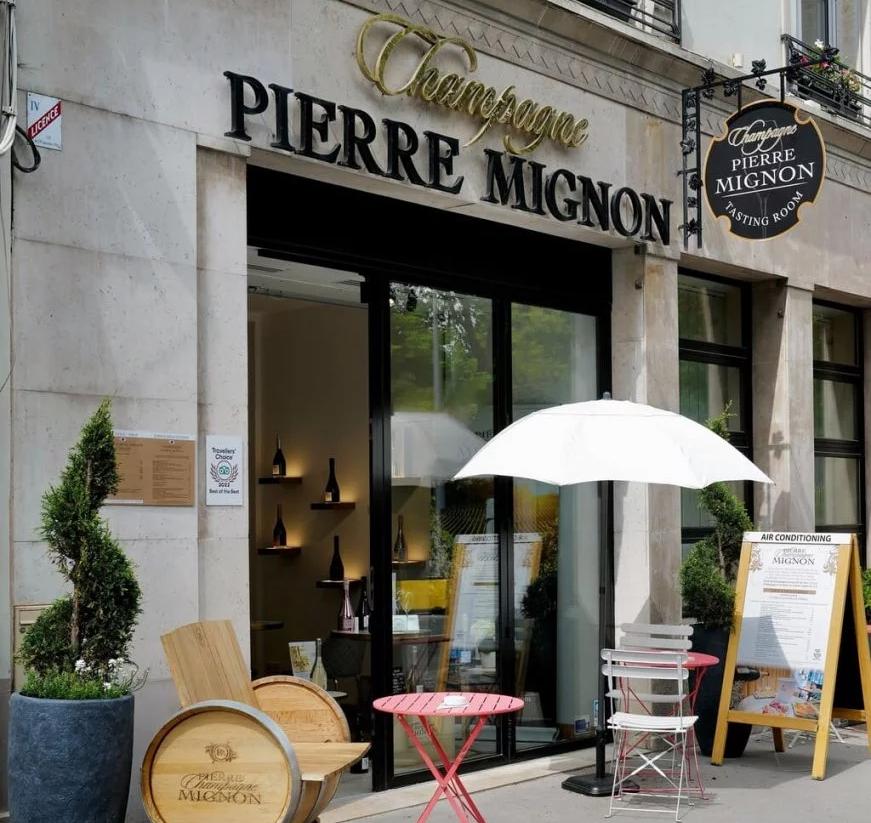
Wine tastings in Reims and Épernay
Exploring the Champagne region is a delight, with many experiences easily accessible from key locations like Reims and Épernay. In Épernay, you can visit Champagne Pierre Mignon and enjoy one of their tasting experiences . While i n Reims, enjoy a unique visit and tasting at Les Sacrés Chais , the first urban winery in Reims. Located in the historic docks, this innovative micro-cellar produces still wines in the heart of the region of bubbles!
There are numerous tasting options in both cities, from historic and grandiose cellars to modern and innovative tasting rooms. Whether you're in Épernay or Reims, you'll find a range of opportunities to indulge in the world of Champagne.
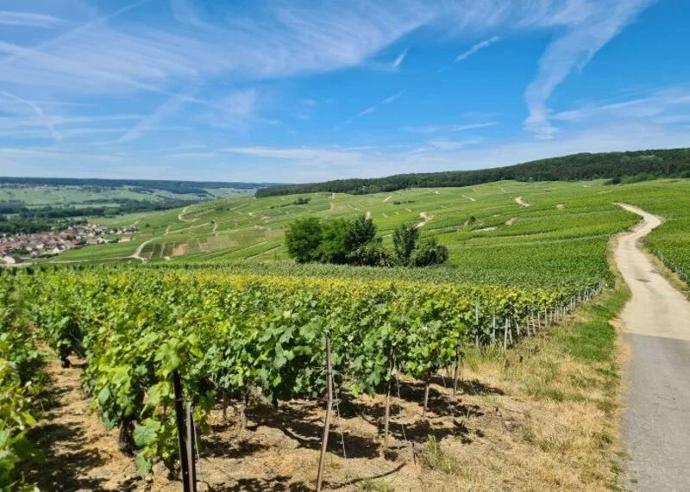
Full day Small group Champagne Wine Tour from Paris
This small group tour, limited to 8 people, lasts around 11 hours and includes a tasting of 8 champagnes and lunch. It starts with a hotel pick-up in Paris, followed by a guided visit to a renowned Champagne house. You'll then explore Hautvillers, home to the abbey of Dom Pérignon, and enjoy lunch at a family-run winery or traditional restaurant with Champagne pairings. The day concludes with a visit to a cooperative or family-owned winery for additional tastings before returning to Paris.
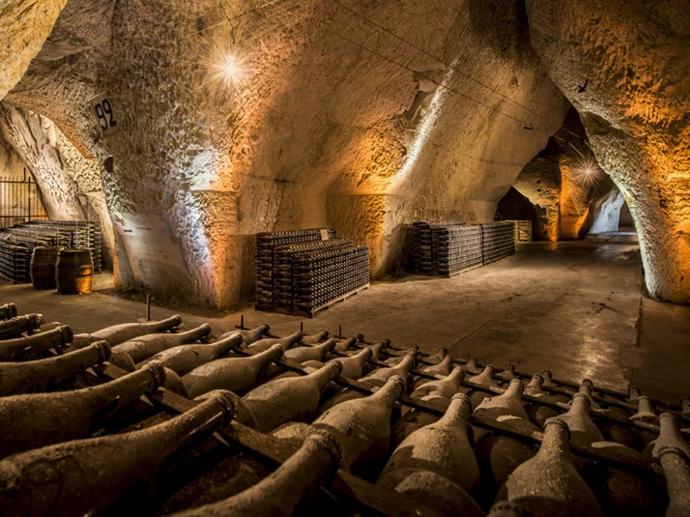
Private Champagne Wine Tour from Paris
This 9-hour tour offers transportation from Bordeaux, electric bikes and helmets, and visits to two wineries with tastings. You'll enjoy a picnic lunch in the vineyards and a guided walk through the UNESCO-listed village of Saint-Émilion. With a group size limited to 8, this intimate experience starts in central Bordeaux and includes scenic cycling through vineyards, typical French picnic, and wine tastings at two wineries. The stroll through historic Saint-Émilion adds a perfect blend of beauty, culture, and wine appreciation.
Wine & Food in Champagne
The Epitome of Sparkling Wines
Champagne is world-renowned for its sparkling wines, crafted with meticulous precision and aged to perfection. Spanning approximately 34,000 hectares (84,000 acres), Champagne's unique chalky soil, combined with a cool continental climate, provides the ideal conditions for producing the finest sparkling wines.
The region's sparkling wines are predominantly blends of three grape varieties: Chardonnay, Pinot Noir, and Pinot Meunier. About 90% of Champagne production is sparkling wine, but the region also produces still wines, known as Coteaux Champenois, and a delicate pink wine called Rosé des Riceys. The art of blending, known as assemblage, is central to Champagne's identity, allowing winemakers to combine wines from different grape varieties, vineyards, and vintages to create complex and consistent flavors.
The history of Champagne dates back to the Roman era, but it was the monks of the Middle Ages who truly developed the methods that define Champagne today. Champagne's prestige is further solidified by the strict regulations that govern its production. Only wines produced in the designated Champagne region using specific methods can bear the appellation Champagne which ensures the quality and exclusivity of these sparkling wines.
The allure of Champagne lies not only in its taste but also in its rich cultural heritage and the meticulous craftsmanship of its producers. From the grand maisons to the small, family-run growers in the 5 subregions of Champagne, each bottle represents a legacy of excellence and a tradition of celebration. Let's explore these 5 unique subregions together.
Exploring the Champagne Subregions
-
Montagne de Reims: Nestled in the northern part of the region, Montagne de Reims is celebrated for its exceptional Pinot Noir, which imparts bold and fruity flavors to the champagnes. The area is home to legendary Champagne houses like Veuve Clicquot, Taittinger, Louis Roederer, Krug and others.
-
Vallée de la Marne: This subregion is dominated by Pinot Meunier, which adds a full-bodied, fruity quality to the wines. The Marne Valley is a mosaic of small growers and renowned houses such as Bollinger and Billecart-Salmon.
-
Côte des Blancs: Renowned for its Chardonnay, the Côte des Blancs produces some of the most elegant and age-worthy Champagnes. The wines from this area are known for their citrusy, mineral-driven profiles that develop beautifully over time. Esteemed producers like Salon and Pol Roger are based here.
-
Côte de Sézanne: Located just south of Côte des Blancs, this area also primarily grows Chardonnay. The Champagnes from this subregion are known for their elegant yet structured flavor profiles.
-
Côte des Bar (Aube): In the southernmost part of the region, the Côte des Bar is distinguished by its sun-drenched vineyards that are ideal for growing Pinot Noir. The Champagnes from this subregion are rich and full-bodied, often exceptional value for money. This subregion joined the Champagne appellation later than others and is an emerging hotspot for wine lovers seeking robust and expressive Champagnes. Champagne Drappier is a notable example.
Now that we have explored the unique characteristics of each subregion, let's delve into the fascinating process that transforms these grapes into the world's most celebrated sparkling wine.
The Intricate Art of Champagne Production
Champagne production is a fascinating and intricate process that involves multiple steps to achieve its signature effervescence and flavor.
Among the various methods to produce sparkling wines, the traditional Méthode Champenoise stands out for crafting some of the finest examples. This method involves a meticulous process of secondary fermentation in the bottle, which dates back to the 17th century and was perfected by the Benedictine monk Dom Pérignon. Nowadays, you can visit Hautvillers, a charming village in the Champagne region, renowned as the home of Dom Pérignon. You can explore the abbey where he lived and worked and learn about his lasting impact on the art of Champagne production.
-
Harvesting, Pressing & Primary Fermentation: After the grapes are hand-harvested and gently pressed, the juice is placed in tanks for the first fermentation, where yeast transforms the natural sugars in the grapes into alcohol, resulting in a still wine.
-
Assemblage: The unique process of blending different base wines to create a consistent house style.
-
Secondary Fermentation: A mixture of yeast and sugar, known as liqueur de tirage, is added to the wine, which is then bottled into thick glass bottles and sealed. The bottles are placed in a cool cellar for secondary fermentation, which produces alcohol and carbon dioxide. The carbon dioxide dissolves into the wine, creating bubbles. As fermentation continues, yeast cells gradually die. The bottles then age on their lees (dead yeast cells) for at least 15 months, as required by appellation regulations, adding complexity and depth to the flavor.
-
Riddling or remuage: The bottles are carefully rotated and tilted to gradually move sediment toward the neck.
-
Disgorging: The neck of the bottle is frozen to remove the sediment.
-
Dosage: A mix of wine and sugar, called liqueur d’expédition, is added to adjust the sweetness and top up the bottle. This step determines the final sweetness level of the bottle of champagne.
-
Finally, the bottle is corked and secured with a wire cage to withstand the pressure, which can be up to 6 atmospheres.
Here's your guide to the different styles of Champagne, ranked from driest to sweetest by their sugar content:
-
Brut Nature or Zero Dosage: This style is very dry with no added sugar, showcasing the wine’s natural flavors and acidity. Ideal for those who love a crisp, clean taste.
-
Extra Brut: Very dry, with a sharp and refreshing taste, this style is ideal for those who enjoy minimal sweetness.
-
Brut: The most popular and widely produced style. It's characterized by a balanced dryness that pairs well with a variety of foods. It’s versatile and a safe choice for any occasion.
-
Extra Dry: Despite its misleading name, Extra Dry is actually slightly sweeter than Brut, and retains a touch of sweetness without being overwhelming.
-
Sec or Dry: These champagnes are moderately sweet, with a noticeable but not overpowering sweetness. They are suitable for pairing with desserts or as an aperitif.
-
Demi-Sec: Sweet and often enjoyed with desserts or as a stand-alone treat because of its pronounced sweetness.
-
Doux: The sweetest style of Champagne, rarely produced nowadays.
The Variety of Champagne Styles
Beyond the varying levels of sweetness, Champagne also comes in a wide array of styles, each offering unique characteristics and suitable for different occasions. These styles are defined by the grape varieties used, the winemaking techniques, and the aging process. Let’s dive into the delightful world of Champagne and uncover what makes each style special!
Non-Vintage (NV)
Made from a blend of wines from multiple years, NV Champagnes are consistent in style and flavor, representing the house's signature taste. NV Champagnes typically age for at least 15 months.
Blanc de Blancs
Made exclusively from Chardonnay grapes, these Champagnes are known for their elegance, acidity, and longevity. Ideal for pairing with seafood and light dishes.
Rosé
Created by adding a small amount of red wine to the blend or by macerating the juice with the skins of black grapes, rosé Champagnes are prized for their color, fruitiness, and complexity. Rosés are versatile and can be enjoyed on their own or paired with a range of foods, from appetizers to desserts.
Vintage
Produced from grapes harvested in a single exceptional year, vintage Champagnes for a minimum of 3 years, but often much longer. This develops more complex flavors and greater aging potential. These Champagnes are perfect for special occasions.
Blanc de Noirs
Produced only from black grape varieties, these Champagnes are rich, full-bodied, with berry and red fruit notes. Being robust and structured, Blanc de Noirs is an excellent choice for pairing with heartier dishes such as roasted meats and aged cheeses.
Prestige or Special Cuvée
The top tier of a Champagne house's offerings, Prestige Cuvées like Dom Pérignon and Krug Grande Cuvée are crafted from the finest grapes and aged the longest. They showcase the pinnacle of winemaking expertise and unique vineyard terroir, making them perfect for prestigious celebrations and significant milestones.
To fully appreciate the flavors and effervescence of Champagne, it's essential to serve it at the correct temperature and in the proper glassware.
Food
Champagne's cuisine is rich and varied, offering several dishes and specialties beyond its famous sparkling wine. Reflecting its rich cultural heritage and diverse agricultural bounty, the region provides a variety of unique dishes and ingredients. Apart from the ones mentioned further in the list, notable examples include Foie de Canard au Champagne, where duck liver is prepared with local Champagne; Truffes de la Marne, black truffles from the Marne area, which add a luxurious touch to various dishes; and Pain d'Épices de Reims (spiced bread), among others.
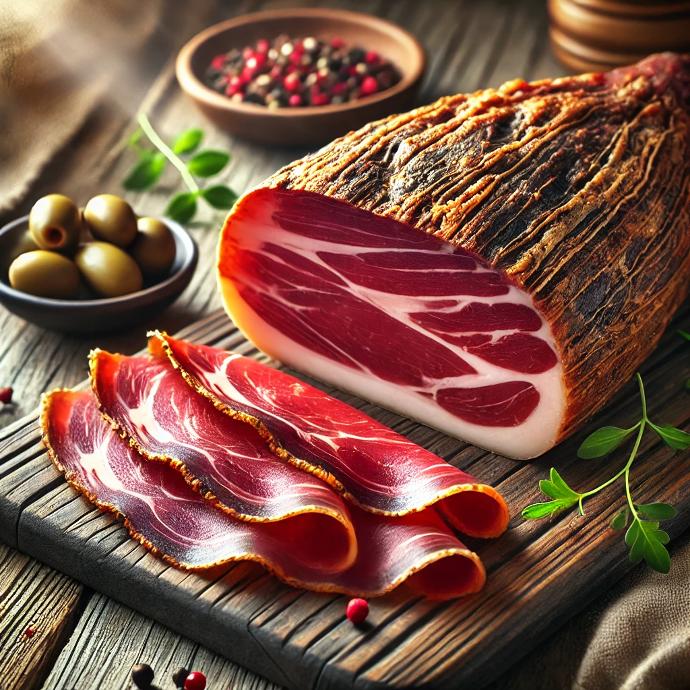
Jambon Sec des Ardennes
A dry-cured ham from the Ardennes region (IGP), known for its rich, savory flavor. This ham pairs beautifully with a glass of Extra Brut Champagne, which cuts through the richness and balances the saltiness.
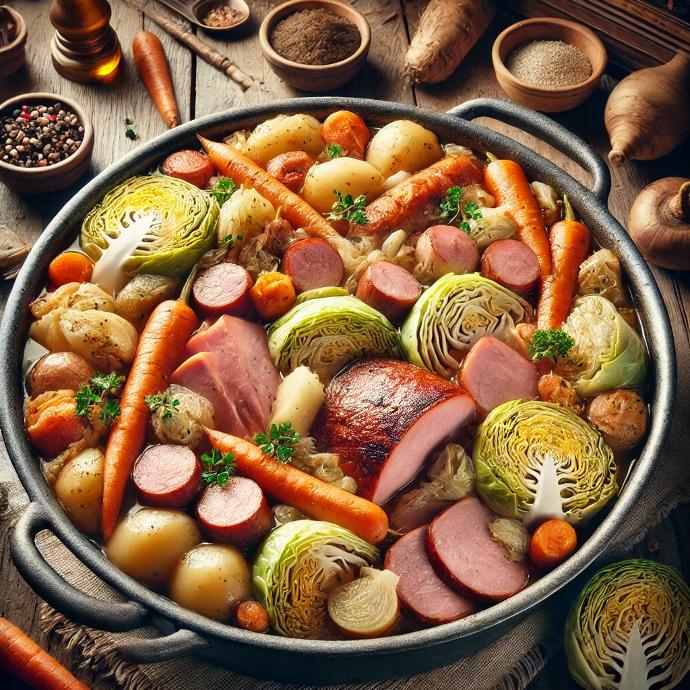
Potée Champenoise
A hearty stew made with pork, cabbage, and root vegetables, simmered in a flavorful broth. The robust flavors of this traditional dish are best complemented by a Blanc de Noirs Champagne, which can stand up to the dish’s richness.
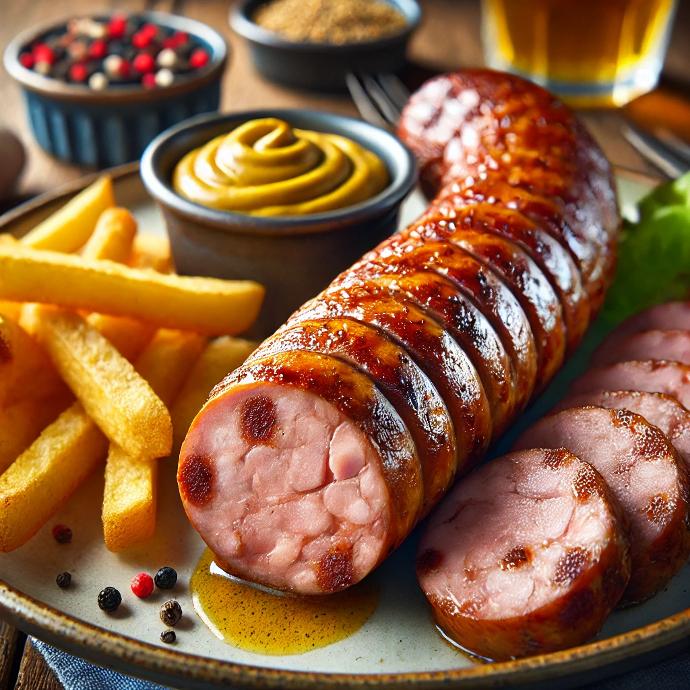
Andouillette de Troyes
A traditional sausage made from pork chitterlings, known for its strong, distinctive flavor. Pair it with a Blanc de Noirs Champagne to complement the savory taste and enhance the overall experience.
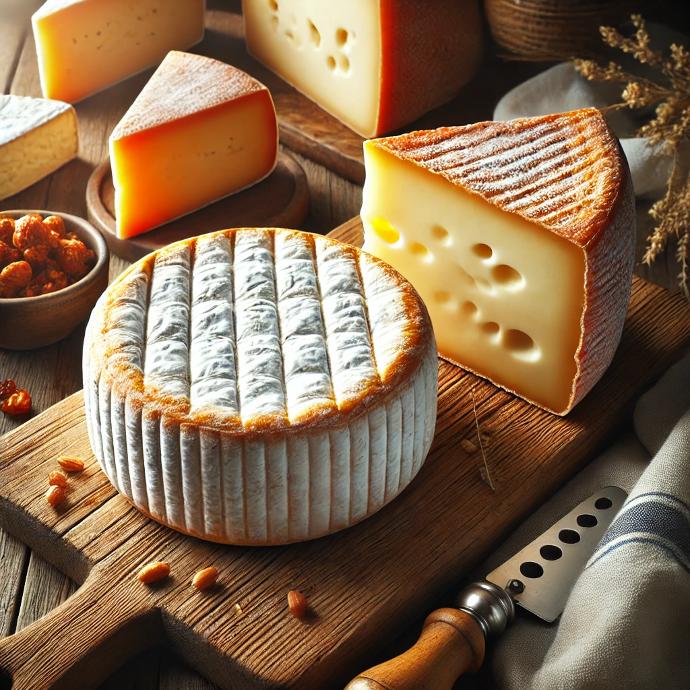
Cheeses
Champagne-Ardenne produces several cheeses.
Chaource
(AOC),
is
a creamy, soft cheese with a mild flavor. Pair it with Blanc de Blancs Champagne to match its creamy texture and enhance its subtle flavors.
Langres
(AOC)
,
a soft, washed-rind cheese with a strong aroma and creamy texture. It pairs well with Vintage Champagne, which balances the
cheese's
robust flavors and texture.
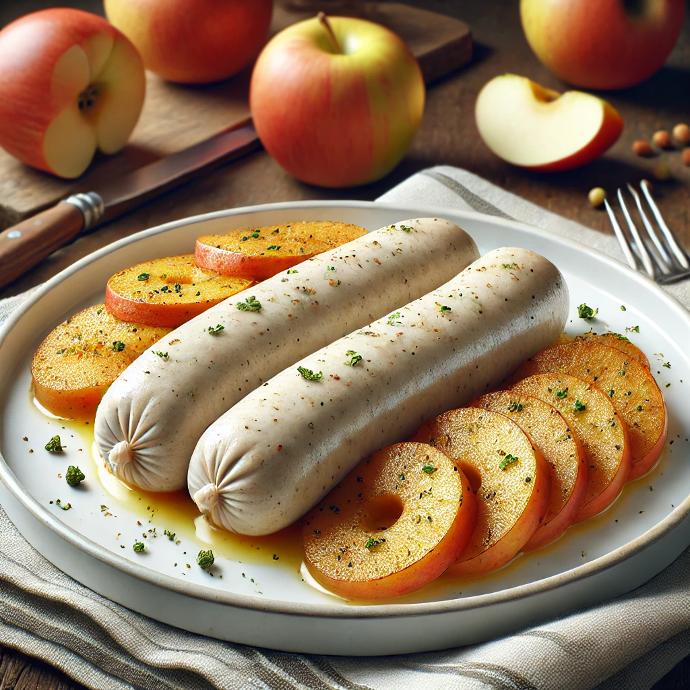
Boudin Blanc
A white sausage made from pork, milk, and spices, often served with apples. Its mild flavor and smooth texture are perfectly complemented by a glass of Rosé Champagne, which adds a touch of fruitiness to the dish.
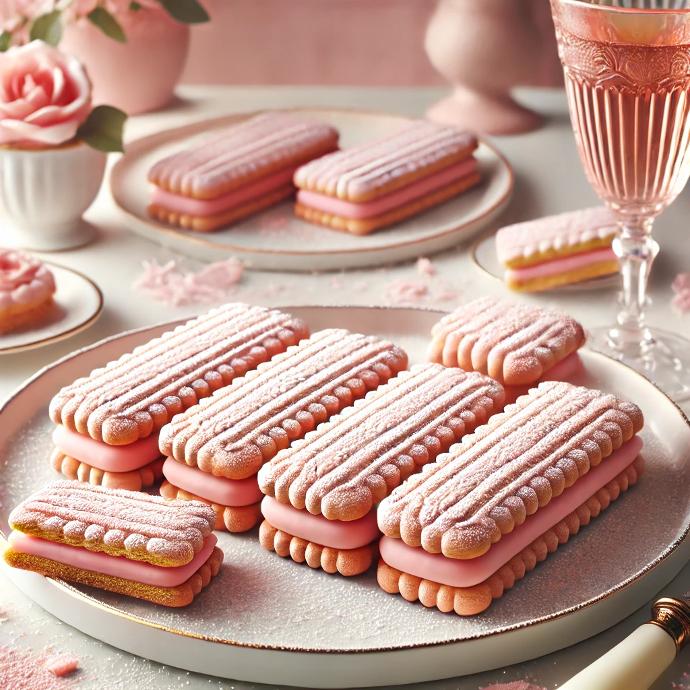
Biscuits Roses de Reims
Delicate pink biscuits traditionally dunked in Champagne. These lightly sweet treats pair wonderfully with Demi-Sec Champagne, as the slight sweetness enhances the flavor without overpowering it.
Top 5 Wine Experiences
Here are our top 5 recommendations for wine experiences in Champagne, carefully selected by Winedering, the world's most popular wine and food experiences marketplace. These experiences, booked by thousands of customers, are the ones we highly recommend for creating unforgettable moments.
E-Bike Tour in the Vineyards & Picnic and Champagne Tasting at Le Relais du Vigneron
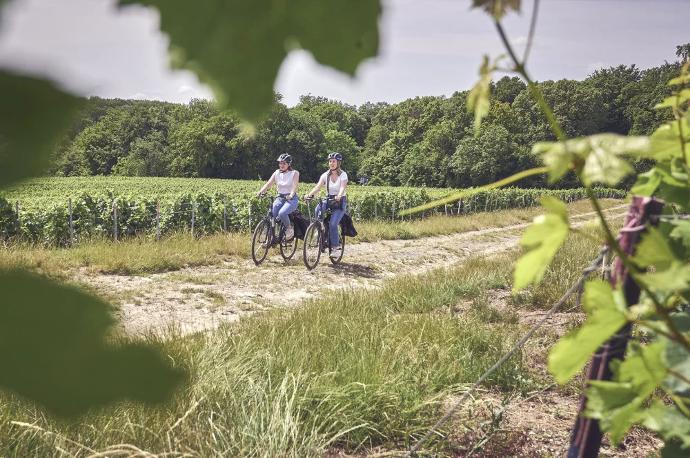
Explore the Côte des Blancs vineyard by electric bike, guided by an interactive app. The tour includes a 15-30 km route with insightful commentary. Enjoy a picnic featuring local products like charcuterie, cheese, terrine, and sweets, paired with a still wine of Champagne - AOC Coteaux Champenois. Conclude with a tasting of 3 champagnes from the Champagne Charles Pougeoise, classified as Premier Cru. This experience is designed for groups of 2; if you're more, opt for one of their vineyard walks instead. The entire experience lasts 3 hours.
Experience type: Bike tour, picnic & tasting
Ideal for: couples and friends
Champagne Enological Lunch at Domaine Julien Chopin
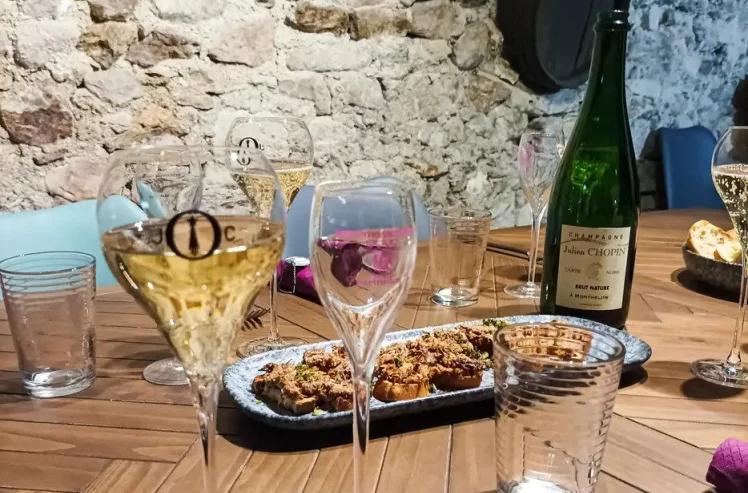
Enjoy a 2-hour enological lunch at Domaine Julien Chopin, featuring a 4-course meal paired with 3 exquisite champagnes and 1 ratafia champenois. This experience combines gourmet dining with expertly selected wine pairings, set in a charming, traditional atmosphere. Ideal for groups of 2 to 6 people, this immersive experience offers a memorable journey of taste.
Experience type: Lunch
Ideal for: couples or small groups
Cellar Tour & Passion Tasting Workshop at Champagne Sanger
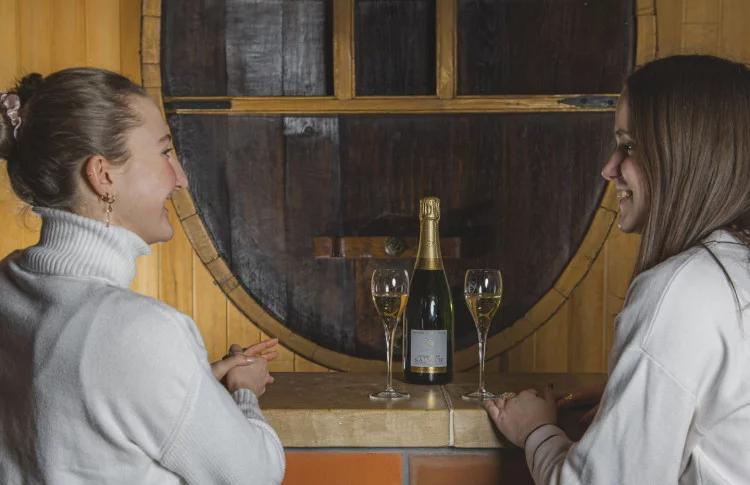
Enjoy this 2-hour workshop at Champagne Sanger. Dive into the estate's history, explore the champagne production process, and taste 4 cuvées from the estate. This experience, praised for its educational value, allows you to enrich your knowledge of champagne under expert guidance. Suitable for small groups of 1 to 8 people, it is available in English, French, and Spanish.
Experience type: Cellar visit and tasting
Ideal for: Couples, friends, small groups
Wine, Art & Beyond: An Immersive Cellar Journey at Champagne Météyer
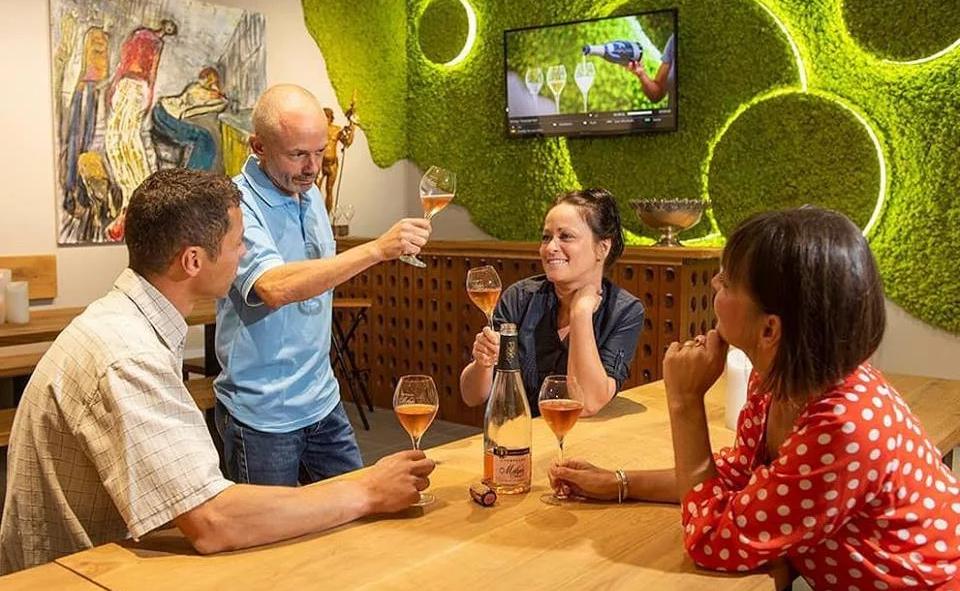
Nestled in the heart of the Marne Valley, experience a 2-hour immersive journey at Champagne Météyer. Begin with an introduction to the family's history and delve into the secrets of Champagne production through museum exhibits and a short film. Explore ancient underground cellars and conclude with a guided tasting of 3 exceptional champagnes.
Experience type: Cellar visit and tasting
Ideal for: Couples, friends, families, groups
Collection Tour & Tasting of 3 champagnes at Champagne Michel Fagot
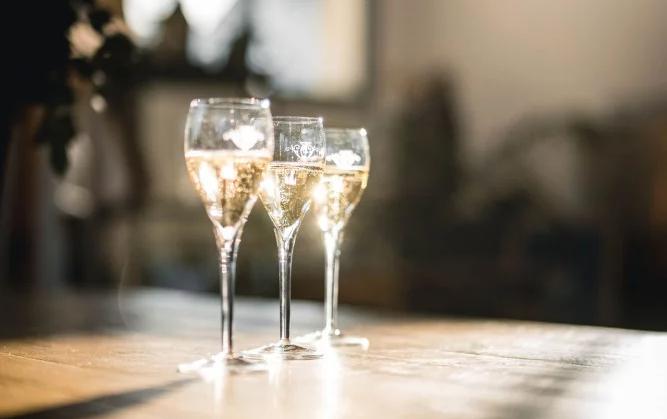
Nestled in the village of Rilly-la-Montagne, in the heart of the prestigious Montagne de Reims, enjoy this 2-hour tour and tasting at Champagne Michel Fagot. This authentic tour includes a detailed description of the Champagne house, an exploration of the traditional cellar, and a look at the house's original press. The experience concludes with a tasting of 3 champagnes.
Experience type: Cellar visit and tasting
Ideal for: Couples, friends, groups of up to 12 people
Itineraries and Wine Tours in Champagne
If you need some inspiration for your next trip or looking to adjust your current reservations in Champagne, check out our top two itineraries recommended by Winedering for the world-famous Champagne region. The Winedering team has meticulously curated these tours to offer an exceptional experience.
Tour #1: Full-Day Champagne Tour with Winery Lunch
Embark on a full-day Champagne adventure from Epernay or Reims. Your journey includes visits to 3 Champagne houses, a delightful enological lunch, and a tasting of 10 diverse champagnes.
/
10 am
At 8 am, depart from Epernay or Reims by car or private driver. If departing from Epernay, leave at 9.30 am; if from Reims, depart 15 min earlier.
/
12 am
Arrival to
Champagne Sanger. Embark on a tour of the cellar and taste 4 cuvées from the estate.
Duration: 2 hours
At 12 am, transfer to Domaine Julien Chopin.
/
2.30 pm
Arrival to
Domaine Julien Chopin
for an
enological lunch paired with 3 champagnes and 1 ratafia.
Duration
: 2 hours
At 2.30 pm, transfer to Champagne Michel Fagot in Rilly-la-Montagne.
/
6 pm
Arrival to Champagne Michel Fagot for tour of the cellar and a tasting of 3 champagnes.
Duration: 2 hours
/
6.30 pm
End your day with a return to Epernay or Reims. Total duration: 9 hours.
Tour #2: Half-Day Vineyard & Gourmet Champagne Tour
Embark on a delightful half-day tour in Champagne, combining vineyard exploration with gourmet wine experiences. By the end, you will have tasted 8 diverse cuvées of Champagne and a variety of local products.
/
10 am
Depart from Epernay or Reims by car / personal driver. If departing from Reims, leave at 9 am; if from Epernay, depart half an hour later.
/
1 pm
At 1 pm, transfer to Champagne Pierre Mignon in Epernay.
/
3 pm
/
3.45 pm
Return to Reims. Total duration: around 6,5 hours.
Enjoy Wine Experiences in Champagne
With detailed itineraries and insider tips, your adventure through the Champagne wine region will be both seamless and enriching.
Remember to take your time, enjoy the stunning views, and soak in the warm hospitality of the local winemakers and residents. Here's to many memorable wine experiences in Champagne, that you can easily book online on Winedering.com, the best online wine tourism marketplace worldwide.
Bon voyage and cheers to an extraordinary and bubbly Champagne adventure!
